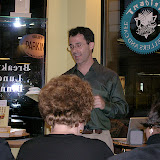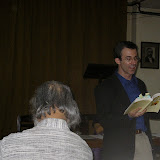Many readers may wonder what the "tenth rasa" is... I include, below, an "enhanced" excerpt from the introduction to the book, by way of explanation. I have also added some
new, unpublished, translation-related information that enhances our understanding of the Bengali word
kheyaal. Below that, in more technical detail, is a defense of this term, based on a discussion I had at JNU in 11/2012.
THE TENTH RASA
from Michael Heyman, "A Nonsense Naissance", the first introduction to The Tenth Rasa: An Anthology of Indian Nonsense New Delhi: Penguin, 2007, with some revisions.
In Sukumar Ray's Preface to
Abol Tabol (1923), his famous collection of nonsense, he included an apologia: “This book was conceived in the spirit of whimsy. It is not meant for those who do not enjoy that spirit.” Part of the function of this was to warn the more serious-minded public and critics away from such a strange literary product. But there is far more meaning to this simple statement, owing to the Bengali words that cannot be directly translated. The “spirit of whimsy” in this passage is, in Bengali, “kheyaal rawsh” and refers to a fundamental classification of Indian aesthetic theory, that of the rawsh, or rasa, as they are more commonly known. All Indian arts are designed to produce complex emotional effects on the audience. These effects are strictly delineated and classified according to Bharata's
Natyasastra (c. 200 AD), an ancient treatise on the arts which includes eight rasas (rawsh in Bengali). The ninth rasa, for "peace", was later appended. Each rasa corresponds to one emotional effect, including love, anger, the comic/happy, disgust, heroism, compassion, fear, wonder, and peace. All serious art must evoke combinations of these rasas (a word which also has the meanings of taste, the “essence” of something, as well as living liquids like sap and juice).
The result of Ray’s inventing this tenth rasa is two-fold. First, it helps to distinguish the nonsense form from other Indian literary forms. As Satpathy has discussed, Tagore initiated this distinction by recognizing that children’s chora represented a separate rasa: “There are nine rasas in our aesthetic theory. But, the chada [or chora], meant for children, contains a kind of rasa which does not fit into any of the nine rasas. The beauty of this rhyme can be called, baalras [children’s ras]. It is neither thick nor pungent. It is, rather, clear, innocent, beautiful, and that which cannot be related to anything” (Lok 52). Tagore was the first to recognize such value in folk rhymes and stories, and according to Chaudhuri, “it was largely owing to his efforts that these began to be recorded and studied seriously” (Writings 2). Having folk material taken seriously was an important step for Indian scholarship and paved the way for Sukumar Ray to distinguish further the genre of nonsense from folk and other forms of literature. Ray’s new rasa is not restricted to children, as Tagore’s is. Rather, it represents the complexity of literary nonsense. As Satyajit Ray, Sukumar’s son, claims in his introduction to his father’s volume, “There are traces of such whimsy in the folk poetry of any nation. But authentic literary nonsense masks its caprice beneath an apparent gravity in an urbane and sophisticated manner unknown in popular rhyme” (5). By creating a tenth rasa, and designating it the prime rasa of nonsense, Ray was thus distinguishing nonsense, the essence of whimsy, from folk material, which only has “traces of such whimsy.” He also was giving it respectability as a genre that includes an adult audience.
More significantly, though, the creation of the rasa of whimsy revises about 1700 years of fundamental aesthetic theory, necessitating that nonsense be considered a serious, even conservative art form. Long before Bharata’s treatise on art, Indian aesthetic theory was well-developed, codified, directly related to religion, and therefore mostly, if not exclusively, serious. Bharata recognized that the “comic” mode existed but marginalized it (at best) by making it share a rasa with “happiness,” a conjunction any modern theory of comedy, such as Freud’s on jokes, would cast doubt upon. The creation of this tenth rasa thus has some quite revolutionary and revisionary effects. Incorporating a kind of thoughtful “whimsy” into the pantheon of rasas, and claiming it to be the primary characteristic of nonsense, legitimizes the genre in the eyes of even the most aesthetically and culturally conservative judges. Furthermore, including the concept of whimsy with the other rasas introduces a rebellious, potentially dangerous concept. “Whimsy,” which is a decent translation of the Bengali
kheyaal, is an “odd fancy; idle notion; whim” or alternatively, a “curious, quaint, or fanciful humor” (Webster’s New World). But the Bengali word, even more than the English word, has a pejorative meaning, especially in the adjectival form. Thus, to sanction that which is odd, idle, contrary, fanciful—all partially in a pejorative sense—is dangerous; it could potentially disrupt the seriousness, the discipline, and the sanctity of the others. In particular, it distinguishes itself from the combined “comedy/happiness” rasa, perhaps showing the inherent rebellion or at least the sheer absurdity of nonsense that Gorey referred to, a mode that is often problematically comic. As French absurdists like Ionesco show, nonsense can be comic, absurd, disquieting, and terrifying all at once. In addition, it is important to note that "
kheyaal" also has connotations of deep thought, in addition to the whimsicality. This connection is the essence of the concept and of the genre of literary nonsense.
As rasas are not temporal creations but rather eternal qualities, Ray’s inclusion of “whimsy” implies that is has always been there, unrecognized, yet affecting the other rasas nonetheless (especially the comic/happy). One would have to go back to reconsider the other rasas in light of the newest “discovery” and completely revise the ways they are used in the arts. Of course, one has to believe in the rasa for the revolution to occur. If the aesthetic pundits of Sukumar Ray’s time had accepted his concept, then he would have succeeded not only in the ultimate “Indianization” of literary nonsense, but in potentially revolutionizing Indian art. His nonsense, not surprisingly, was not taken as seriously as he would have liked, though it did become wildly popular, and continues to be to this day. West Bengal is also one of the few areas in India where nonsense is taken seriously by adults. His was but a beginning for this still nascent art form in India.
Works Cited
Ray, Sukumar. (SNSR) The Select Nonsense of Sukumar Ray. Trans. Sukanta Chaudhuri. Calcutta: OUP, 1987.
-------.(AT) Abol Tabol: The nonsense world of Sukumar Ray. Trans. Sampurna Chattarji. New Delhi: Puffin, 2004.
Tagore, Rabindranath. Selected Writings for Children. Ed. Sukanta Chaudhuri. New Delhi: OUP, 2002.
-------. Khapchhada, 1937
-------. “Lok sahitya” (folk literature) in The Works of Rabindranath Tagore, Vol. 3. Calcutta: Bishorbharati University Press, 1986.
The Tenth Rasa? Really?
Update: 11/2012:
At a recent lecture at JNU, I encountered some fellows who were experts in rasa theory. They were quick (oh very quick) to quibble with the nomenclature of nonsense as a "tenth" rasa. They pointed out that other theorists over the years have conceived of rasas since the more established eight (plus one), so this shouldn't be considered the tenth, nor did Ray ever call it the tenth. Well, these are facts--but they are missing the big picture. My point for calling this the "tenth" rasa is not at all about numbers--but about the idea that Sukumar Ray was proposing a rasa beyond the traditional nine. So I called it the tenth, as a kind of shorthand. It's that simple... When Tagore invented what he called baal ras or the pure rasa of childhood, I'd say he was also inventing a "tenth" rasa. I do understand why rasa theorists would (and probably should) quibble here, but I hope this kind of strict analysis doesn't overshadow the greater meaning, and what I would say Sukumar was aiming at.
Another argument these fellows gave was that, since the ninth rasa, shanti (or peace), is meant to encompass all the rasas, that there couldn't be a tenth. Again, if one subscribes to this, then there surely can't be additional rasas. Still, I'd submit that Rabindranath Tagore, Sukumar Ray, and others did indeed propose additional rasas, and so (unless we claim that they were simply wrong), we should consider the possibility of the tenth (and eleventh...).
Lastly, these fine fellows argued that my analysis was based on a mistranslation of Ray's term kheyaal rawsh. They raise a fair point: rawsh, or rasa, in addition to its use in aesthetic theory, can also be used in a more literal meaning: that of juice/flavor/sap. And also that kheyaal does not translate very well to "whimsy"--that it has a broader sense to it (which I won't go into here). They are correct--these are possibilities. Not being a native Bengali speaker, nor a linguist who might deal with early twentieth century usage of the term, I'm afraid I have relied on other sources for my interpretation. I would only submit here, according to what I've gathered from scholars and speakers of Bengali, that there are different possible interpretations, and that while the literal reading offered by the JNU scholars is a possibility, it is also possible that Ray very well did mean to refer to aesthetic theory--and something that translates to "whimsy" loosely (but see my intro below for the qualification of that translation).

